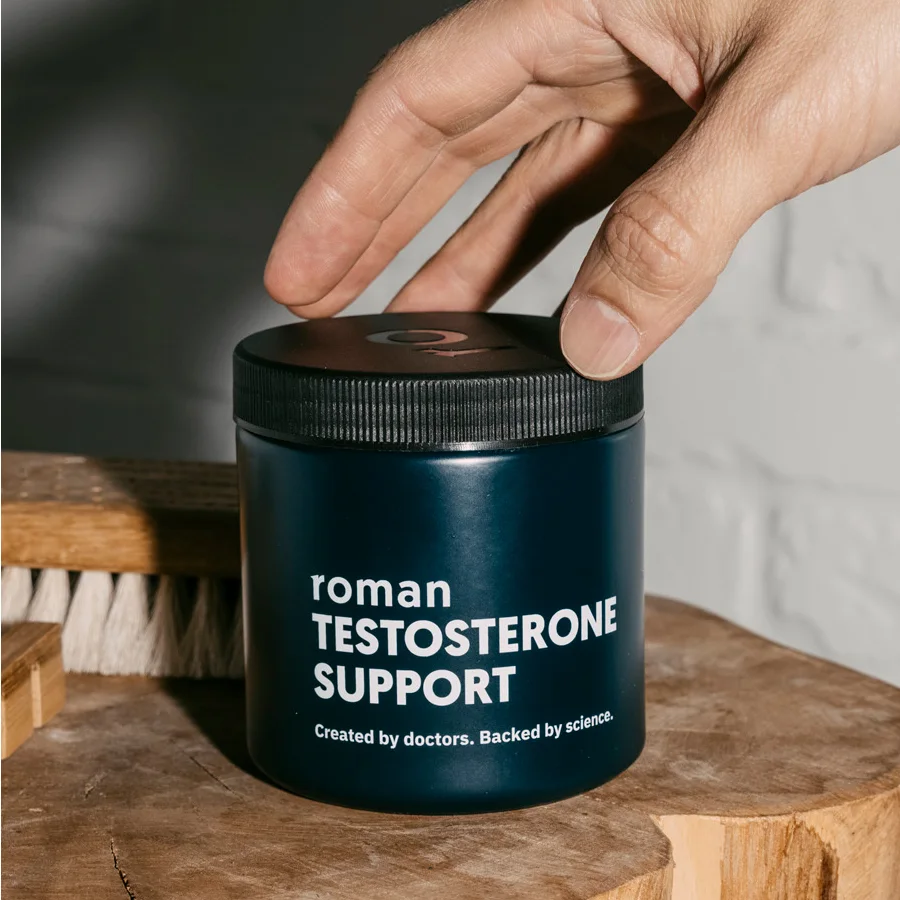Here's what we'll cover
Here's what we'll cover
Here's what we'll cover
Many people experience low testosterone. However, some treatments (like testosterone replacement therapy) can lead to side effects like infertility. Clomid may be one option to treat low testosterone while preserving fertility, or it may be prescribed to treat male infertility. Continue reading to learn more.
Clomiphene Important Safety Information: Read more about serious warnings and safety info.
What is Clomid?
Clomid (active ingredient, clomiphene citrate) is a drug originally developed to treat female infertility by encouraging ovulation but is sometimes used off-label to treat low T and/or infertility in men. This means the US Food and Drug Administration (FDA) doesn’t specifically approve clomiphene for this purpose, though many healthcare providers will prescribe it to improve low T and sperm production.
Clomid uses for men
Testosterone levels decrease naturally with age. Signs and symptoms of low testosterone include decreased libido, erectile dysfunction (ED), fatigue, and muscle weakness.
If you’ve experienced low T, you may have heard of testosterone replacement therapy (TRT) as a treatment option. While effective, there is one potential downside: TRT can adversely impact male fertility. That’s why some people opt for an alternative treatment like Clomid.
In addition to treating low testosterone in some men, Clomid may be prescribed to treat male infertility (off-label), especially when low testosterone is detected. However, more research is needed to understand the efficacy of Clomid in treating male infertility. A recent review of studies testing the efficacy of Clomid in treating male infertility yielded “varied and unreliable” results (Chehab, 2015). Other small, limited studies showed promising results when combining Clomid with vitamin E, but more research is needed (ElSheikh, 2015).
How does Clomid work?
Clomid treatment in men works by tricking your brain into thinking there’s not enough testosterone in your system. Your body responds by ramping up its natural production of the hormone. This way, you can increase testosterone levels without harming your fertility (Krzastek, 2019).
The testicles are the factories that make testosterone, but your brain is in charge of managing the whole thing. When the brain senses that your body has enough testosterone, it shuts down the factory. However, sometimes its sensors are a bit off, and it shuts down production even when testosterone levels aren’t quite where they should be.
That’s where Clomid can help. Taking clomiphene encourages your brain to release two hormones: LH (luteinizing hormone) and FSH (follicle-stimulating hormone). These hormones tell the testicles when to ramp up testosterone production (Mbi Feh, 2022).
Because Clomid doesn’t dull testosterone production like TRT, it maintains male fertility. Research also suggests clomiphene is safe and effective for treating low testosterone (Krzastek, 2019).
Side effects of Clomid
Common side effects people reported while taking Clomid include (Krzastek, 2019):
Mood changes
Chest tenderness
Blurry vision
Rarely, people will experience other adverse reactions like high blood pressure (hypertension), altered taste, asthma, flushing, nausea, excess thirst, and joint aches.
One study showed that Clomid is well tolerated over a three-year treatment period. It also found that Clomid helped the majority of participants to see symptoms improve and reach normal testosterone levels after three years of therapy (Krzastek, 2019).
Clomid drug interactions
If you’re prescribed Clomid to treat low testosterone or infertility, tell your healthcare provider about any other medications you take. There are no documented specific drug interactions with Clomid, but talk to your healthcare professional if you have any questions (DailyMed, 2021).
What is low testosterone?
Low testosterone is a common condition that affects approximately 40% of men over age 45. Having low T can lead to a host of health problems like decreased muscle strength, low sex drive, and erectile dysfunction (Sizar, 2022).
If you think you have low testosterone levels, the only way to know for sure is to have your blood levels tested. Your healthcare provider may order blood tests to check what’s called your total and free testosterone levels. Since these are the highest in the morning, most providers will recommend checking your levels between 8–10 AM (Nassar, 2022).
Testosterone replacement therapy
A common treatment for low T is testosterone replacement therapy (TRT). In essence, TRT gives your body the testosterone it isn’t producing. Testosterone therapy comes in several forms, including injections, pellets, gels, and patches.
While effective, TRT does have side effects. One major one is that it can harm sperm production and cause male infertility. That’s because, over time, TRT shuts down your body’s natural production of sperm and testosterone (Patel, 2019).
How can I naturally boost testosterone?
In addition to medical interventions like taking Clomid, some people pursue ways to naturally boost testosterone production. Research suggests exercise––like high-intensity interval training (HIIT) or resistance training—may lead to higher hormone levels (Riachy, 2020).
Sleep is the time when your body produces the most testosterone. If you're not getting enough quality sleep (for example, if you have a condition like sleep apnea), your testosterone levels may drop. Aim to get 7–9 hours of sleep each night for your testosterone factories to work their best (Liu, 2019).
If you have questions about male infertility, low testosterone, or Clomid, speak with a healthcare provider or fertility specialist to create a treatment plan that’s right for you.
DISCLAIMER
If you have any medical questions or concerns, please talk to your healthcare provider. The articles on Health Guide are underpinned by peer-reviewed research and information drawn from medical societies and governmental agencies. However, they are not a substitute for professional medical advice, diagnosis, or treatment.
References
Chehab, M., Madala, A., & Trussell, J. C. (2015) On-label and off-label drugs used in the treatment of male infertility. Fertility and Sterility, 103 (3) 595-604. doi:10.1016/j.fertnstert.2014.12.122. Retrieved from https://www.fertstert.org/article/S0015-0282(14)02553-9/fulltext#%20
DailyMed. (2021). Clomiphene citrate tablet. Retrieved on Sept. 23, 2022 from https://dailymed.nlm.nih.gov/dailymed/drugInfo.cfm?setid=be399623-6400-475d-93d3-1dedd4d43017
ElSheikh, M. G., Hosny, A., Elshenoufy, H. et al. (2015) Combination of vitamin E and clomiphene citrate in treating patients with idiopathic oligoasthenozoospermia: A prospective, randomized trial. Andrology 3(5) 864-867 doi:10.1111/andr.12086. Retrieved from https://onlinelibrary.wiley.com/doi/10.1111/andr.12086
Krzastek, S. C., Sharma, D., Abdullah, N., et al. (2019). Long-term safety and efficacy of clomiphene citrate for the treatment of hypogonadism. The Journal of Urology , 202 (5), 1029–1035. doi:10.1097/JU.0000000000000396. Retrieved from https://pubmed.ncbi.nlm.nih.gov/31216250/
Leproult, R. & Van Cauter, E. (2011). Effect of 1 week of sleep restriction on testosterone levels in young healthy men. Journal of the American Medical Association , 305 (21), 2173–2174. doi:10.1001/jama.2011.710. Retrieved from https://pubmed.ncbi.nlm.nih.gov/21632481/
Liu, P. Y. (2019). A clinical perspective of sleep and andrological health: assessment, treatment considerations, and future research. The Journal of Clinical Endocrinology and Metabolism , 104 (10), 4398–4417. doi:10.1210/jc.2019-00683. Retrieved from https://www.ncbi.nlm.nih.gov/pubmed/31042277
Mbi Feh, M. K. & Wadhwa, R. (2022). Clomiphene. StatPearls . Retrieved on Sept. 23, 2022 from https://www.ncbi.nlm.nih.gov/books/NBK559292/
Muthusami, K. R. & Chinnaswamy, P. (2005). Effect of chronic alcoholism on male fertility hormones and semen quality. Fertility and Sterility , 84 (4), 919–924. doi:10.1016/j.fertnstert.2005.04.025. Retrieved from https://pubmed.ncbi.nlm.nih.gov/16213844/
Nassar, G. N. & Leslie, S. W. (2022). Physiology, testosterone. StatPearls . Retrieved on Sept. 22, 2022 from https://www.ncbi.nlm.nih.gov/books/NBK526128/
Patel, A. S., Leong, J. Y., Ramos, L., & Ramasamy, R. (2019). Testosterone is a contraceptive and should not be used in men who desire fertility. The World Journal of Men's Health , 37 (1), 45–54. doi:10.5534/wjmh.180036. Retrieved from https://www.ncbi.nlm.nih.gov/pmc/articles/PMC6305868/
Riachy, R., McKinney, K., & Tuvdendorj, D. R. (2020). Various factors may modulate the effect of exercise on testosterone levels in men. Journal of Functional Morphology and Kinesiology , 5 (4), 81. doi:10.3390/jfmk5040081. Retrieved from https://www.ncbi.nlm.nih.gov/pmc/articles/PMC7739287/ .
Rivas, A. M., Mulkey, Z., Lado-Abeal, J., & Yarbrough, S. (2014). Diagnosing and managing low serum testosterone. Proceedings , 27 (4), 321–324. doi:10.1080/08998280.2014.11929145. Retrieved from https://www.ncbi.nlm.nih.gov/pmc/articles/PMC4255853/
Sizar, O. & Schwartz, J. (2022). Hypogonadism. StatPearls . Retrieved on Sept. 23, 2022 from https://www.ncbi.nlm.nih.gov/books/NBK532933/
Sato, K., Iemitsu, M., Katayama, K., et al (2016). Responses of sex steroid hormones to different intensities of exercise in endurance athletes. Experimental Physiology , 101 (1), 168–175. doi:10.1113/EP085361. Retrieved from https://pubmed.ncbi.nlm.nih.gov/26518 1 51/
Wheeler, K. M., Sharma, D., Kavoussi, P. K., et al. (2019). Clomiphene citrate for the treatment of hypogonadism. Sexual Medicine Reviews , 7 (2), 272–276. doi:10.1016/j.sxmr.2018.10.001. Retrieved from https://pubmed.ncbi.nlm.nih.gov/30522888/










